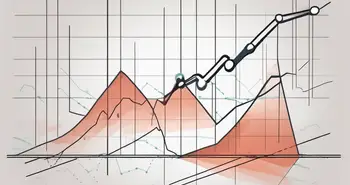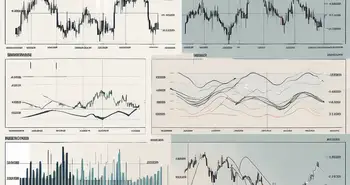Understanding the Money Flow Index: A Comprehensive Guide

Hello readers, welcome to my comprehensive guide on understanding the Money Flow Index (MFI). In this article, we will dive deep into the world of MFI and explore its concept, mathematical formula, practical usage, common misconceptions, and the advantages and disadvantages of using it in trading. So let's get started and unravel the secrets of the Money Flow Index!
Introduction to Money Flow Index
Before we delve into the details, let's briefly introduce the Money Flow Index. MFI is a popular technical indicator that measures the strength and direction of money flowing in and out of a particular asset or security. It combines both price and volume to provide traders with valuable insights into market trends and potential reversals.
But what exactly is the Money Flow Index and how does it work? Let's explore its underlying principles and understand its significance in trading.
The Concept of Money Flow Index
To understand the concept of MFI, we need to explore its underlying principles. MFI is based on the idea that when the price of an asset closes higher than the previous price, it indicates buying pressure, while a close lower than the previous price suggests selling pressure. By analyzing the volume of trades associated with these price movements, MFI calculates a value that ranges from 0 to 100. This value helps traders determine whether an asset is overbought or oversold.
Imagine you are a trader analyzing the price and volume data of a particular stock. You notice that the stock's price has been consistently closing higher than the previous price, indicating a strong buying pressure. Simultaneously, the volume of trades associated with these price increases has also been significant. This combination of price and volume data is precisely what the Money Flow Index takes into account.
By calculating the Money Flow Index, traders can gain insights into the overall strength of the buying or selling pressure in the market. A high MFI value, close to 100, suggests a strong buying pressure, indicating that the asset may be overbought. On the other hand, a low MFI value, close to 0, suggests a strong selling pressure, indicating that the asset may be oversold.
Importance of Money Flow Index in Trading
Now you may be wondering, why is MFI important in trading? Well, MFI helps traders identify potential trend reversals, divergences, and overbought/oversold conditions. It acts as a powerful tool for identifying entry and exit points, enhancing trading strategies, and managing risks effectively. By incorporating MFI into your trading arsenal, you can gain a competitive edge in the market.
Let's consider an example to understand the importance of MFI in trading. Imagine you are monitoring a stock that has been experiencing a prolonged uptrend. The price has been steadily rising, and the volume of trades has been increasing as well. However, as the price continues to climb, you notice that the MFI value has reached an extremely high level, close to 100. This indicates that the stock may be overbought, and a potential trend reversal could be on the horizon.
With this valuable information provided by the Money Flow Index, you can make informed decisions about when to enter or exit a trade. You may choose to sell your position or even consider shorting the stock, anticipating a potential price decline. By using MFI as a confirming indicator alongside other technical analysis tools, you can enhance your trading strategies and increase your chances of success.
In conclusion, the Money Flow Index is a powerful technical indicator that combines price and volume data to provide traders with insights into market trends and potential reversals. By understanding the underlying principles of MFI and its importance in trading, you can effectively incorporate it into your analysis and decision-making process. Remember, knowledge and utilization of various technical indicators, such as the Money Flow Index, can significantly enhance your trading skills and profitability.
The Mathematical Formula Behind Money Flow Index
Let's now explore the mathematical formula that lies at the heart of the Money Flow Index. Understanding the components and interpretation of this formula is crucial for harnessing the full potential of MFI.
Components of the Money Flow Index Formula
The MFI formula consists of several steps. It starts by calculating the typical price (TP), which is the average of the high, low, and closing prices for a given period. Next, it calculates the raw money flow (RMF) by multiplying TP with the volume traded. Then, it categorizes the RMF as positive or negative based on the price movement. Finally, the MFI value is calculated using a formula that incorporates positive and negative money flows over a specified time period.
Interpreting the Money Flow Index Values
Interpreting the MFI values is equally important in making informed trading decisions. An MFI reading above 80 is typically considered overbought, indicating a potential reversal or cooling off period. Conversely, an MFI reading below 20 is viewed as oversold, suggesting a potential buying opportunity. Understanding these values helps traders identify favorable market conditions.
How to Use Money Flow Index in Trading
Now that we have a solid understanding of the MFI concept and formula, it's time to explore how we can utilize it in our trading strategies. Let's delve into two key applications of MFI: identifying overbought and oversold conditions, and spotting divergences and convergences.
Identifying Overbought and Oversold Conditions
MFI is a valuable tool for identifying overbought and oversold conditions in the market. When the MFI reading exceeds 80, it suggests that the asset may be overextended and due for a pullback. On the other hand, when the MFI reading drops below 20, it indicates that the asset may be oversold and potentially ready for a rebound. Traders can use these MFI signals in conjunction with other technical indicators for more accurate predictions.
Spotting Divergences and Convergences
Another way to utilize MFI is by spotting divergences and convergences. Divergence occurs when the price of an asset moves in the opposite direction of the MFI reading. This could indicate a potential trend reversal. Conversely, convergence occurs when the price and MFI reading move in the same direction, reinforcing the current trend. Identifying these patterns can be a powerful tool for timing entry and exit points.
Common Misconceptions about Money Flow Index
Now, let's address some common misconceptions surrounding MFI. It's crucial to understand these misconceptions to avoid making erroneous trading decisions based on faulty interpretations of the indicator.
Misinterpretation of Overbought and Oversold Signals
One common mistake traders make is solely relying on overbought and oversold signals provided by MFI. While high or low MFI readings indicate potential reversals, it's essential to consider other technical indicators and market conditions to validate these signals. MFI should be used as part of a comprehensive trading strategy, rather than the sole indicator for making buy or sell decisions.
Relying Solely on Money Flow Index for Trading Decisions
Another misconception is relying solely on MFI for making trading decisions. While MFI is a powerful indicator, it should be used in conjunction with other indicators, such as moving averages, trend lines, and support/resistance levels. Combining multiple indicators increases the reliability of trading signals and reduces the chances of false positives.
Advantages and Disadvantages of Using Money Flow Index
Now, let's weigh the pros and cons of incorporating MFI into your trading strategy.
Benefits of Incorporating Money Flow Index into Trading Strategy
One significant advantage of using MFI is its ability to identify potential trend reversals and overbought/oversold conditions. By catching these signals early, traders can enter or exit positions at more favorable prices, maximizing profits and minimizing losses. Additionally, MFI provides valuable insights into market sentiment, strengthening the overall analysis of an asset's price action.
Limitations of Money Flow Index
While MFI has its merits, it's crucial to acknowledge its limitations. MFI, like any technical indicator, is not foolproof and can produce false signals. It's vital to use MFI in conjunction with other indicators and consider broader market context. Furthermore, MFI may not perform well in certain market conditions, such as low-volume or highly volatile periods, where other indicators may provide more accurate insights.
FAQ – Frequently Asked Questions
Q: What is the Money Flow Index?
The Money Flow Index is a technical indicator that combines price and volume to measure the strength and direction of money flowing in and out of a particular asset or security.
Q: How can I use the Money Flow Index in trading?
You can use MFI to identify overbought and oversold conditions, spot divergences and convergences, and enhance your overall trading strategy.
Q: Should I rely solely on the Money Flow Index for trading decisions?
No, it's recommended to use MFI in conjunction with other indicators and consider broader market context for more accurate trading decisions.
To conclude, the Money Flow Index is a valuable tool for traders seeking to gain insights into market trends, potential reversals, and overbought/oversold conditions. By understanding its concept, formula, and limitations, you can harness the power of MFI and apply it to enhance your trading strategy. Remember, combining MFI with other indicators and maintaining a holistic approach is key to successful trading. Happy trading and may the money flow in your favor!
Ready to take your trading to the next level with the insights from the Money Flow Index? Discover the innovative world of Morpher, where traditional trading meets the cutting-edge advantages of blockchain technology. With zero fees, infinite liquidity, and the ability to trade a multitude of assets including stocks, cryptocurrencies, and more, Morpher.com is the platform for traders who demand more. Sign up now to experience the future of investing with fractional shares, short selling, and up to 10x leverage. Plus, get your free sign up bonus to start your journey. Sign Up and Get Your Free Sign Up Bonus and join the revolution at Morpher.

Disclaimer: All investments involve risk, and the past performance of a security, industry, sector, market, financial product, trading strategy, or individual’s trading does not guarantee future results or returns. Investors are fully responsible for any investment decisions they make. Such decisions should be based solely on an evaluation of their financial circumstances, investment objectives, risk tolerance, and liquidity needs. This post does not constitute investment advice.

Painless trading for everyone
Hundreds of markets all in one place - Apple, Bitcoin, Gold, Watches, NFTs, Sneakers and so much more.

Painless trading for everyone
Hundreds of markets all in one place - Apple, Bitcoin, Gold, Watches, NFTs, Sneakers and so much more.









